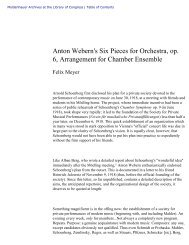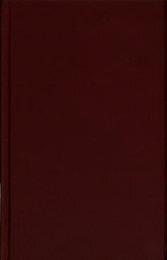Country Profile: Cuba - American Memory - Library of Congress
Country Profile: Cuba - American Memory - Library of Congress
Country Profile: Cuba - American Memory - Library of Congress
Create successful ePaper yourself
Turn your PDF publications into a flip-book with our unique Google optimized e-Paper software.
<strong>Library</strong> <strong>of</strong> <strong>Congress</strong> – Federal Research Division <strong>Country</strong> <strong>Pr<strong>of</strong>ile</strong>: <strong>Cuba</strong>, September 2006<br />
in Havana among <strong>Cuba</strong>, Bolivia, and Venezuela on April 29, 2006, <strong>Cuba</strong> will import Bolivian<br />
coca leaves for “legal consumption,” as well as Bolivian soybeans and quinoa.<br />
<strong>Cuba</strong> has actively participated in regional trade organizations not subject to a U.S. veto. It was a<br />
founding member <strong>of</strong> the Association <strong>of</strong> Caribbean States in 1995; joined the Latin <strong>American</strong><br />
Integration Association in 1999 and the Caribbean Forum <strong>of</strong> African, Caribbean and Pacific<br />
States (Cariforum) as a full member in 2001; completed a trade and economic cooperation<br />
agreement with the Caribbean Community in 2002; belongs to the Caribbean Tourism<br />
Organization; and has indicated a desire to negotiate with the Common Market <strong>of</strong> the South<br />
(Mercado Común del Sur—Mercosur) and the Andean Community. Fidel Castro attended the<br />
Mercosur summit in Argentina in July 2006.<br />
Imports: <strong>Cuba</strong>’s imports dropped by 73 percent between 1990 and 1993 in the absence <strong>of</strong> export<br />
earnings and access to financing. However, import capacity, led by tourism revenue, has<br />
improved over the past decade. Imports <strong>of</strong> goods free on board totaled US$7 billion in 2005 and<br />
were projected to total US$7.9 billion in 2006 and US$8.5 billion in 2007. Principal imports in<br />
2005 included foodstuffs (US$1.6 billion), fuels (US$1.8 billion), and machinery and equipment<br />
(US$1.7 billion). Other imported goods include chemicals (US$531 million in 2004).<br />
In 2004 Venezuela was the leading source <strong>of</strong> imports, accounting for 21.3 percent <strong>of</strong> the total,<br />
followed by Spain (12 percent), China (11 percent), the United States (9.8 percent), Italy (5.1<br />
percent), and Canada (4.9 percent). Estimated imports from Venezuela in 2005 totaled about<br />
US$1.4 billion, US$1.1 billion <strong>of</strong> which was oil (about 90,000 barrels per day) and US$300<br />
million, food and other products. The estimate for 2006 was US$2 billion. Imports from China in<br />
2005 also surged, to about US$560 million, making China <strong>Cuba</strong>’s second-largest trading partner<br />
that year. After U.S. agricultural restrictions on exports to <strong>Cuba</strong> were partially lifted in 2001,<br />
one-way trade with the United States resumed in 2002 and totaled more than US$900 million<br />
during 2002–4 (no <strong>Cuba</strong>n exports to the United States are allowed). However, the growth <strong>of</strong> this<br />
trade subsequently ended and began to decline after payment rules were tightened in early 2005.<br />
Exports: Exports <strong>of</strong> goods free on board totaled US$2.7 billion in 2005 and were projected to<br />
total US$2.8 billion in 2006 and US$3.3 billion in 2007. <strong>Cuba</strong>’s main exports in 2005 included<br />
nickel (US$1.2 billion), sugar and its by-products (US$168 million), and tobacco products<br />
(US$243 million). Other export products include medicines (US$130 million in 2004), seafood,<br />
citrus and tropical fruits, and c<strong>of</strong>fee. Despite its decline, sugar remains an important export<br />
earner, second only to nickel as a commodity export, and is expected to earn about US$250<br />
million in 2006. Although volume varies from year to year, <strong>Cuba</strong>’s main export destinations in<br />
2004 were the Netherlands (29.4 percent, a figure that includes goods shipped to the Netherlands<br />
for onward shipment to other European Union countries), Canada (22.4 percent), Venezuela<br />
(10.2 percent), Spain (8 percent), China (7.8 percent), and Russia (7.3 percent). Russia’s<br />
purchases in 2004 represented a steady decline since 1999, when it purchased 22.2 percent <strong>of</strong><br />
<strong>Cuba</strong>’s exports.<br />
Trade Balance: Trade figures for 2005–7 project continuing deficits in goods trading: US$4.3<br />
billion in 2005, US$5.1 billion in 2006, and US$5.2 billion in 2007. However, the services<br />
balance improved from close to zero in 1990 to an estimated surplus <strong>of</strong> US$2.6 billion in 2005<br />
17



![Albert Einstein Papers [finding aid]. Library of Congress. [PDF ...](https://img.yumpu.com/21604228/1/190x245/albert-einstein-papers-finding-aid-library-of-congress-pdf-.jpg?quality=85)





![American Colony in Jerusalem Collection [finding aid]. Library of ...](https://img.yumpu.com/17941275/1/190x245/american-colony-in-jerusalem-collection-finding-aid-library-of-.jpg?quality=85)



![Piccard Family Papers [finding aid]. - American Memory - Library of ...](https://img.yumpu.com/17941234/1/190x245/piccard-family-papers-finding-aid-american-memory-library-of-.jpg?quality=85)


